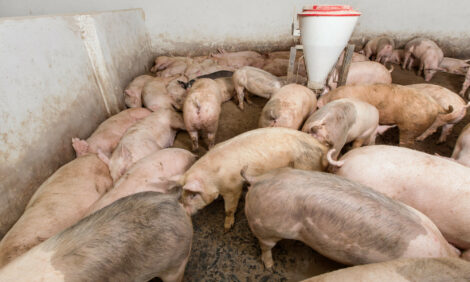



Drinking Behavior of Nursery Pigs During Oral Vaccine Administration
By Anna K. Johnson, assistant professor; Roy A. Edler, Boehringer, Ingleheim, Vetmedica; J. Tyler Holck, Boehringer, Ingleheim, Vetmedica; Brad V. Lawrence, Boehringer, Ingleheim, Vetmedica; Robert G. Baker, undergraduate. Reprinted from the Iowa State University Animal Industry Report 2007.Summary and Implications
Oral vaccination of swine via their drinking water is an increasingly common practice. Improved understanding of swine drinking behavior is needed to ensure immunization of an entire population.
Introduction
Water requirements for pigs are not as well understood as those for other nutrients. Some research has been conducted in determining drinking bouts3, water disappearance in grow-finisher pigs4 and the amount of water needed for different stages of growth1,2. Enterisol® Ileitis FF is a Lawsonia intracellularis vaccine used in drinking water for a minimum of four hours to offer protection against proliferative enteropathy (ileitis). Understanding temporal drinking patterns is therefore very important for veterinarians, animal health companies and producers when administering vaccines via the drinking water. Therefore, the objective of this pilot study was to determine how long it took for 100 % of nursery pigs to visit the drinker when observations began at 7, 8, 9 or 10 am respectively over three consecutive days. The objectives of this larger study were to 1) evaluate how many hours are required to have 100% of nursery pigs visit the drinker at least once when observations began at 0700 h, and 2) to determine if overnight water withholding influenced these results. The water withholding component will be reported in a later publication.
Materials and Methods
Eight pens (1.52 x 3.66 m) housing 23 to 26 seven-week old PIC pigs (10.91 ± 0.35 kg) per pen were used in a cross-over design to visually record drinking behavior. Pigs were randomly assigned to pen by sex. Each pen of pigs had ad. libitum access to a corn-soybean meal based diet and access to water via one metal nipple-cup bowl drinker. Plywood sheets were placed between pens to disrupt social interactions between pigs of adjoining pens. Drinking behaviors were recorded over two consecutive days in late March 2006. Lights were turned on at 0700 h and off at 1600 h each day. Ambient temperature and humidity were recorded. One day prior to visual recording all pigs were identified with an individual number placed between their shoulder blades. One 12V color CCTV camera (Model WV-CP484, Panasonic® Matsushita Co Ltd., Japan) was positioned over each drinker. A pig was considered to be drinking when its head was above the drinker for at least 5 consecutive seconds.
Results and Discussion
High and low temperature and humidity from 0700 to 1300 h in the room over both days were 29.1oC and 24.01oC, and 66.6% and 31.9%, respectively. Percent of pigs visiting the drinker within a 2 hour period ranged from 79 to 100% over two days. Within a 4 hour period the range was 96 to 100%. By 6 hours 100% of the pigs had visited the drinker at least once (Table 1). Only one pen had 100% of the pigs visit the drinker within the first hour.

These results are consistent with our previous pilot study indicating a 6 hour vaccine administration period is necessary to ensure that 100 % of the nursery pigs have ample opportunity to visit the drinker for at least a 5 second drinking bout. We recommend administering oral vaccines via drinking water for a minimum of 4 hours with a preference for 6 hours.
Further Information
To view other articles from the Animal Industry Report 2007 click hereMarch 2007









